Explore Kite Surfing Lessons in Charleston, SC
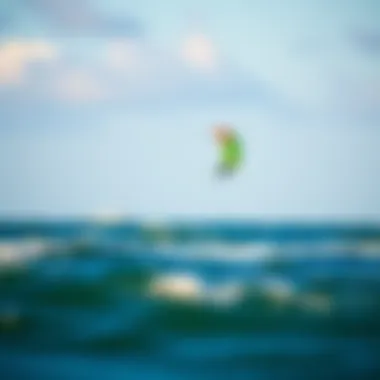
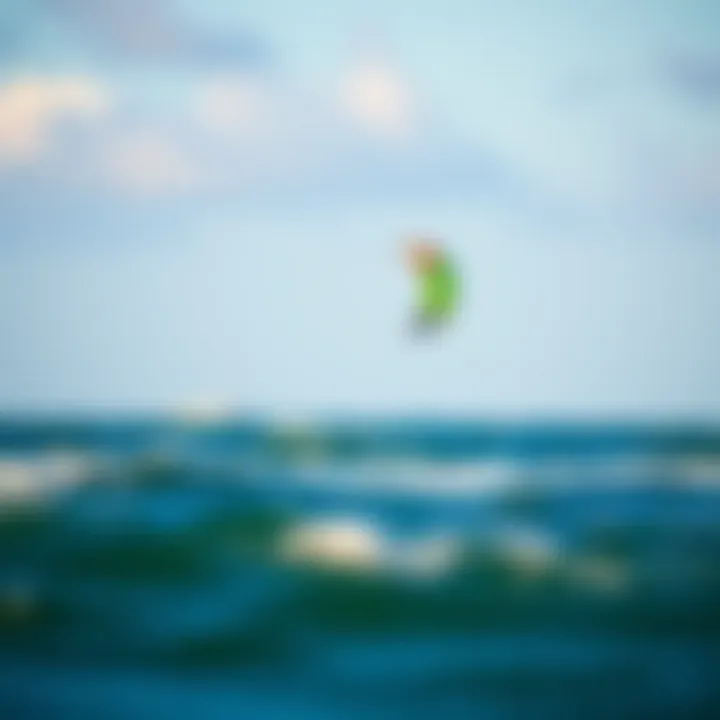
Intro
Kite surfing, a sport that blends elements of windsurfing, surfing, and paragliding, has been picking up steam along the shores of Charleston, South Carolina. The picturesque landscape, with its endless coastline and ideal wind conditions, creates a vibrant backdrop for both novices and seasoned kite boarders alike. If the rush of skimming over the water while being powered by the wind excites you, this locale holds plenty of lessons and tips to get you started.
Learning to kite surf is not merely about catching waves; it’s an experience that combines skill, patience, and respect for the ocean. It may seem daunting at first, but with the right guidance, anyone can pick it up. From understanding the necessary gear to mastering the right techniques, this article digs into everything you should know about taking kite surfing lessons in Charleston.
Gear Insights
In the world of kite surfing, the tools of the trade can make a world of difference. Whether you're just dipping your toes into this thrilling sport or looking to upgrade your setup, understanding the essentials of kite boarding gear is crucial.
Latest Gear Reviews
Modern kite surfing gear has evolved dramatically, offering a range of options that suit various skill levels and preferences. Here are some standout pieces that have been garnering attention on the water:
- Duotone Rebel 2021: Praised for its versatility, this kite is perfect for riders looking to progress quickly. It pulls hard yet offers a smooth flying experience.
- Naish Pivot: Known for its responsiveness, the Pivot is great for powered tricks and easy relaunching. It’s suitable for those looking to up their freestyle game.
- Slingshot Whisper: This board is engineered for performance and stability. It's lightweight and provides effortless gliding on the water, making it ideal for beginners.
These options are tailored to meet the varying needs of kite surfers. Focusing on durable materials and user experience can significantly enhance your performance on the water.
Essential Gear for Beginners
If you’re just getting started, you don’t need to break the bank to get quality gear. Here’s a list of basics that every beginner should consider:
- Kite: Choose a kite that suits your weight and skill level. A smaller kite is usually more manageable.
- Board: A wider board provides greater stability, making it easier to balance as you learn.
- Harness: Opt for a comfortable and reliable harness that won’t dig into your sides when you fall.
- Safety Gear: Don’t skimp on a good helmet and impact vest. They protect you from falls and potential collisions.
Equipping yourself with the right gear sets the foundation for a successful learning experience.
Techniques and Tips
Once you’ve mastered the gear, it’s time to delve into the nitty-gritty of kite surfing techniques. While the vast ocean may look inviting, knowing how to handle the wind and water is paramount.
Advanced Tricks and Techniques
For those who are ready to kick it up a notch, here are a few advanced maneuvers to aim for:
- Jumping: A classic kite surfing thrill. Practicing pop and lift technique can get you soaring.
- Handle Pass: This trick involves passing the kite handle from one hand to the other mid-air. It requires practice and timing.
Safety Practices for Kiteboarders
Navigating the water safely is essential in kite surfing. Here are safety practices that help minimize risks:
- Know the Wind Conditions: Understanding how the wind affects water conditions can prevent mishaps.
- Practice Self-Rescue Techniques: In case you encounter trouble, being able to perform self-rescue can save your life.
- Respect No-Kite Zones: Stay clear of designated swimming areas and busy beaches.
Kite surfing in Charleston is an exhilarating journey. With the right mindset, quality lessons, and an understanding of both gear and safety, you can dive into this sport with confidence. Each wave becomes a step closer to mastering the art of kite surfing.
Prologue to Kite Surfing
Kite surfing, a breathtaking blend of surfing, windsurfing, and paragliding, has carved a niche in the hearts of many coastal enthusiasts. In Charleston, South Carolina, this sport gains further allure due to the area's stunning landscapes and favorable wind patterns. The growing popularity of kite surfing serves not only as a thrilling activity but also as a unique way to connect with nature and experience the surrounding waterways.
As one embarks on this adventure, it’s crucial to grasp the foundational aspects of kite surfing and appreciate its appeal. For wind and water aficionados, kite surfing offers an unmatched sense of freedom and exhilaration. Whether you're an adventurous soul who's always dreamed of harnessing the wind or a traveler keen on exploring Charleston’s stunning shoreline, understanding kite surfing lays the groundwork for your journey.
Definition of Kite Surfing
At its core, kite surfing involves riding on a board while being propelled by a large kite. The kite, controlled by the rider, captures the wind, creating the lift necessary to glide across the surface of the water. While the mechanics might sound straightforward, the art of kite surfing requires skill, timing, and a good understanding of wind dynamics. Riders learn to steer and adjust their kite, facilitating jumps, flips, and other impressive maneuvers.
Emergence and Growth of the Sport
Kite surfing emerged in the late 20th century, around the mid-1980s, when enthusiasts began experimenting with various kite designs to maximize speed and control on the water. The sport rapidly evolved, fueled by advancements in equipment and an increasing number of enthusiasts spreading the word.
In recent years, kite surfing has seen a surge in popularity. One can find those deftly navigating the waters of Charleston, often joined by others seeking lessons or simply witnessing the beauty of this aerial sport. The community of kite surfers is vibrant, encouraging newcomers and veterans alike to share their passion for this exhilarating pastime.
Charleston's coastal experiences enrich the sport by offering unique local conditions favorable for kite surfing. As such, the area has become a prime destination for both inspires and instructors eager to share their knowledge. In this way, the sport's evolution is not just tied to individual experiences but also significantly influenced by local geography and community.
With a backdrop of breathtaking coastal vistas and a friendly community spirit, kite surfing lessons in Charleston present an irresistible invitation for both locals and visitors. Understanding the sport's definition and appreciating its historical context lays the groundwork for diving deeper into the specifics of lessons and the experience of kite surfing itself.
The Charleston Kite Surfing Scene
Charleston, South Carolina, isn't just another coastal town; it's a haven for kite surfing enthusiasts of all levels. The unique geographical features and prevailing winds create an inviting environment for both novices and seasoned riders. With its mix of sandy beaches and open waters, this city offers the perfect backdrop for kite surfing lessons. Whether you're a curious traveler wanting to dip your toes into a new sport or a local looking to hone your skills, understanding the kite surfing scene in Charleston is crucial.
Overview of Charleston's Geography
The geographical layout of Charleston plays a pivotal role in its kite surfing appeal. The area boasts several significant bodies of water, including the Atlantic Ocean and various tidal creeks. Folly Beach, for instance, is widely recognized for its excellent kite surfing conditions. Here, the surf is manageable, and the scenic views are unmatched.
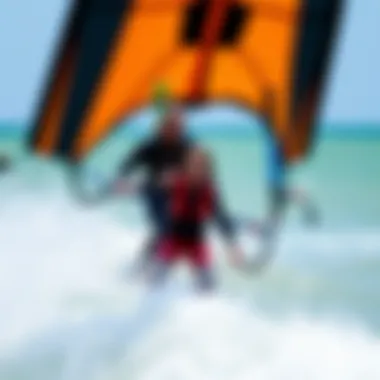
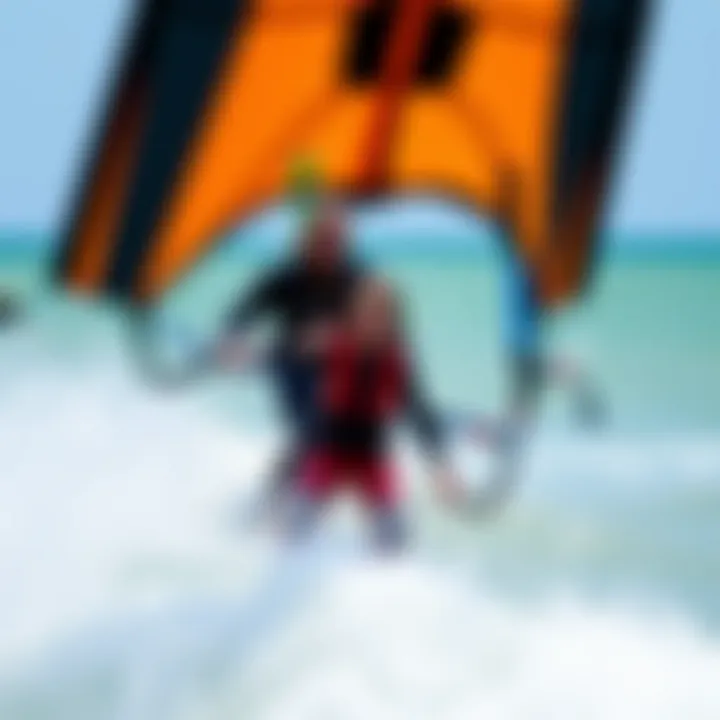
In addition to beaches, the marshy ecosystems nearby provide protection from more extreme elements, making it a safer space for learners. Because the waters are shallow near the shores, beginners can easily gain confidence while practicing. Plus, the mild weather makes kite surfing a year-round adventure, creating numerous opportunities to hit the water.
Ideal Kite Surfing Conditions
When it comes to kite surfing, conditions are everything. In Charleston, wind patterns tend to be quite favorable. The trade winds, which typically blow from the east, give kite surfers reliable 10 to 25-mile-an-hour winds, ideal for catching air and gliding over the waves. This consistency is one of the reasons why kite surfing lessons here attract participants from far and wide.
Key factors contributing to the ideal conditions include:
- Wind Consistency: The steady breezes create an optimal environment for learning and progressing in skills.
- Mild Temperatures: The waters remain warm enough for year-round surfing, unlike in many northern regions where kite surfing is a seasonal sport.
- Varied Locations: With spots like Shem Creek and Isle of Palms, each place brings its character, allowing surfers to experiment with different techniques and styles.
Understanding the environment is half the battle in kite surfing. Knowledge of your surroundings can vastly improve not just your enjoyment but also your safety.
By embracing the elements of Charleston’s kite surfing scene, students not only learn the ins and outs of the sport but also develop a deep appreciation for their coastal surroundings. The combination of favorable conditions, diverse landscapes, and a supportive community make Charleston a prime destination for anyone looking to dive into kite surfing.
Choosing the Right Lessons
Finding the best kite surfing lessons is crucial. You want to make sure that you're not just learning how to control a kite, but also picking up skills that can help you on the water. The options can be overwhelming—individual lessons, group settings, online tutorials, and in-person instruction. Each choice caters to different learning preferences and goals, making it essential to consider a few factors before you jump in. Picking the right lessons can set you on a path to becoming a confident kite surfer.
Types of Kite Surfing Lessons Offered
Individual versus Group Lessons
Individual lessons have their special perks. When you choose one-on-one instruction, you get personalized attention. An experienced instructor can focus solely on your technique, guiding you through your strengths and weaknesses without distraction. This tailored approach is especially beneficial for newcomers who might feel shy in a group.
On the flip side, group lessons can be a lot of fun. You might find camaraderie with fellow novices, making the learning curve less daunting. There’s a certain thrill in watching others as they progress, and sometimes competition can push you to improve. However, more people means shared teaching time, which may slow your personal development.
Those who thrive in social environments might lean towards group lessons, while others who want swift feedback and rapid progress might find individual instruction a smarter pathway.
Online versus In-Person Instruction
In today’s digital age, online instruction has carved a niche in various sports, kite surfing included. This method allows you to learn from the comfort of your home. You can access a wealth of resources—videos, tutorials, and forums—at almost any time. It’s flexible, fitting well into busy schedules, and it allows you to absorb theory without being rushed.
However, real kite surfing skill comes from doing. In-person lessons connect you physically with the sport, making them irreplaceable for mastering practical skills. A live instructor can make quick adjustments on the spot, addressing safety concerns and providing live feedback essential for your success on the water. While online learning provides convenience, in-person instruction offers real-world practice that online methods just can't replicate.
Selecting Qualified Instructors
Certifications and Experience
The training you receive often depends on the instructor’s background. Certifications from recognized organizations demonstrate a level of professionalism and knowledge. When selecting instructors, look for those who have certifications from reputable kiteboarding bodies. Experience in teaching is equally important; seasoned instructors will have a better grasp of common pitfalls in learning and can tailor their approach to your unique needs.
A well-qualified instructor can ensure that you are not just learning but also practicing in a safe and effective manner, setting a solid foundation for your future in kite surfing.
Student Reviews and Feedback
Checking student reviews can provide a glimpse into an instructor’s teaching style and effectiveness. Search for testimonials on social media platforms like Facebook, or forums such as Reddit. Feedback from former students can highlight an instructor's strengths and weaknesses, giving you a clearer picture of what to expect. Look for patterns in feedback—if many students mention an instructor's patience or ability to explain, those may be indicators of their teaching prowess.
Balancing reviews with your personal expectations can help narrow down your choices. Don't hesitate to reach out and ask questions; a good instructor will be happy to discuss their methods and experience with you.
Preparing for Your First Lesson
Getting ready for your first kite surfing lesson is not just about showing up at the beach with an adventurous spirit. It involves a bit more thought and preparation. Understanding the essentials—including the right gear and having the right mindset—can make a world of difference in your learning experience. This section will help you navigate through the initial steps required to maximize your enjoyment and safety in this exhilarating sport.
Essential Gear for Beginners
When you’re about to jump into the world of kite surfing, having the right equipment can set you up for success. So what exactly do you need?
Kite and Board Types
The kite itself is the heart of your kite surfing experience. There are mainly two types of kites: inflatable kites and foil kites.
- Inflatable Kites: These are very popular among beginners. Their structure helps in providing stability and ease of control. The ability to inflate and deflate them makes transportation easy. Due to their buoyancy, they can ride gustier winds, which is great for a newcomer who might struggle with technique.
- Foil Kites: Mostly used by experienced surfers, foil kites can be complex to manage. However, they excel in lighter winds. Significant advantage? They stay inflated without any support, making them light and efficient once mastered.
Boards come in various shapes and sizes, like twin-tips and directional boards.
- Twin-Tip Boards: These are excellent for beginners because they can be ridden both ways. They offer more versatility and ease of use as you learn to turn and control your direction on the water.
- Directional Boards: These are more like surfboards. They can offer thrills in waves but might be a tougher nut to crack for newbies.
Choosing the right kite and board types can vastly enhance your overall experience.
Safety Equipment Requirements
Safety can’t be overstated in kite surfing. Before stepping on that board, ensure you have the vital safety gear.
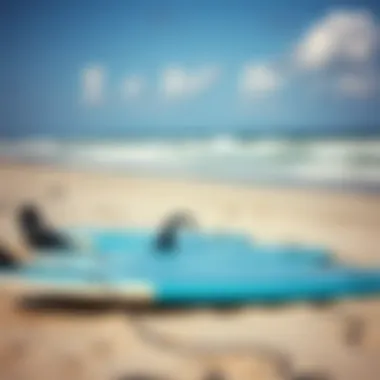
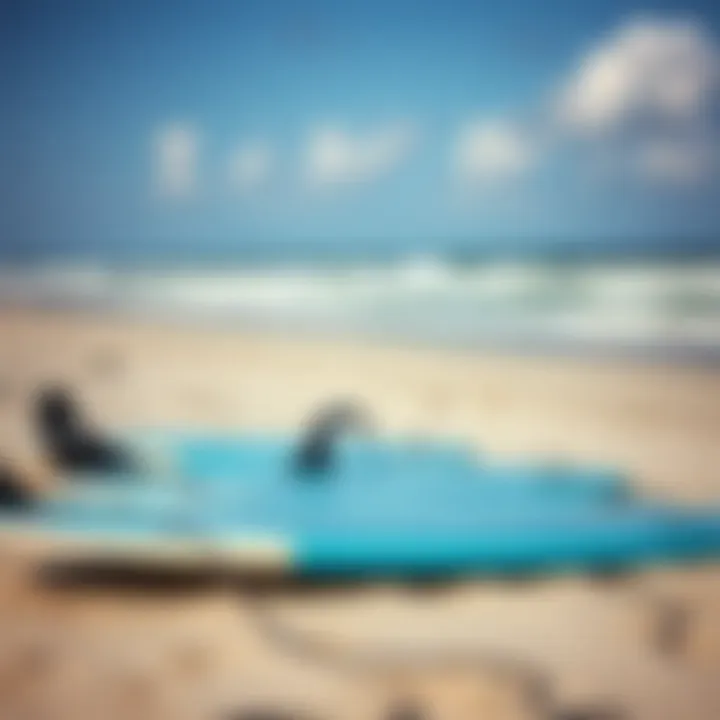
- Harness: This connects you to the kite and is crucial for controlling your movements. A well-fitted harness not only provides safety but also allows you to enjoy a more comfortable ride.
- Life Jacket: A personal floatation device is something you should never skip. Even if you’re in shallow water, it can help you stay afloat without exerting much effort. You never know when you might take an unexpected dip.
- Helmet: Protecting your head is a must especially when you’re learning. Helmets are crucial as they can prevent serious injuries during falls or collisions.
- Safety Leash: This connects you to the kite. If you lose control, the leash ensures the kite drifts away safely instead of being a runaway vehicle in the water.
Having the right safety equipment not only keeps you protected but also instills a sense of confidence while you’re learning.
Physical and Mental Readiness
Before hitting the waves, understanding your physical limits as well as mental preparedness can be just as important as your gear.
Being in decent shape is helpful, but you don’t need to be a fitness guru. Just some basic fitness will do, especially core strength, which aids in balance.
On the mental side, bringing an open mind can make a big difference. Kite surfing can be overwhelming, especially in the beginning; it’s easy to feel like a fish out of water. Embrace the learning curve—there will be times of frustration. Keeping a positive attitude will not only make your first lesson enjoyable but also help you absorb the tips from your instructor.
In essence, proper preparation goes a long way in ensuring that your initial kite surfing experience is both enjoyable and fruitful. Whether it’s understanding gear or getting your mindset ready, each step counts in diving into this exciting world.
In-Depth Look at Lesson Structure
The structure of kite surfing lessons is not only crucial but also quite fascinating. This segment dives into how lessons unfold, focusing on various elements that ensure an effective learning experience. Understanding how lessons are structured allows potential kiteboarders to feel more comfortable when stepping onto the water for the first time.
Typical Lesson Agenda
A well-structured lesson agenda encompasses several key components that aid in the gradual progression of skills. Each segment builds upon the last, ensuring that students feel both challenged and supported.
Warm-Up and Check Equipment
Before any thrilling starts, a warm-up and equipment check play pivotal roles. The warm-up serves to prepare the body for the physical demands of kite surfing, preventing injuries. Checking equipment ensures safety and proper function.
One noteworthy aspect of this phase is its strong emphasis on safety. Instructors often take time to ensure that every piece of gear—from the kite to the harness—is in proper working order. This not only boosts confidence but also sets the tone for a successful session. However, failing to adequately warm up or check equipment can lead to mishaps, so giving this phase the proper attention is a wise move.
Land-Based Instruction
Land-based instruction bridges the gap between theory and practice, offering a safe environment where beginners can familiarize themselves with kite control before hitting the water. Students learn the essential mechanics of flying a kite, understanding wind patterns, and how to position themselves relative to the wind, all while on dry land.
The beauty of land-based education lies in its risk-free nature. This allows learners to experiment without fear, making it an incredibly beneficial aspect of kite surfing lessons. However, it does require patience and focus because theoretical knowledge needs to be intertwined with practical skills.
Water Practicum
Finally, the water practicum is where everything comes full circle. It’s the moment when students take their newly acquired skills and apply them directly on the water. Instructors provide hands-on guidance, ensuring that students can safely launch and control their kite in the ocean.
This experience is genuinely exhilarating—the feeling of harnessing wind and gliding over water is something that can’t be replicated elsewhere. However, it does come with challenges, such as navigating shifting winds and adjusting to the water conditions. Yet, pushing through these obstacles is part of the learning journey.
Common Techniques Taught
Kite surfing is as much about technique as it is about thrill. Understanding fundamental skills and techniques is crucial for a successful kite surfing experience.
Understanding Wind Directions
One core aspect of kite surfing is understanding the wind. In lessons, instructors emphasize how wind direction affects kite control and surfing performance. Recognizing where the wind is coming from and how to use it can significantly impact a rider's overall experience.
This understanding is foundational. It empowers kite surfers to make real-time adjustments, enhancing both safety and enjoyment. However, mastering wind directions requires keen observation and quick thinking, which can take time to develop.
Controlling the Kite
Controlling the kite is the heart of kite surfing. Students learn how to steer, stop, and launch their kites effectively, which is vital when transitioning from theory to practice. Instructors often introduce techniques such as edging and power control to help students feel confident.
The importance of precise kite control can’t be understated. It allows surfers to navigate the water successfully and enjoy every moment of their adventure. However, mastering this skill may require practice and can sometimes lead to initial frustrations—yet perseverance yields remarkable rewards.
Safety Protocols in Kite Surfing
Kite surfing is not just about the thrill of gliding across water; it’s also about ensuring safety while enjoying this exhilarating sport. Understanding safety protocols is vital for everyone involved, from beginners to seasoned pros. Bad weather or incorrect techniques can lead to accidents that ruin the fun and pose risks to one’s well-being. This section delves into necessary safety practices that kite surfers in Charleston should adopt, helping them enjoy their time on the water while minimizing dangers.
Understanding Weather and Conditions
The foundation of safe kite surfing lies in knowing the weather and environmental conditions. Not many realize that kite surfers must observe more than just the wind speed; there are several elements at play:
- Wind Direction: Kite surfers must be cognizant of wind direction. A strong crosswind can catch the kite off guard, so it's crucial to know how to launch and land it accordingly.
- Current and Tides: Charleston has fluctuating tides that affect the water's surface. Familiarizing oneself with local tide schedules is key to identifying safe spots for kite surfing.
- Weather Changes: Sudden storms can emerge in coastal areas. Always check local weather forecasts before heading out. A sunny day can quickly turn into something dangerous when storm clouds roll in.
In Charleston, the typical weather patterns often make for excellent kite surfing conditions, particularly in the spring and fall. However, it’s prudent to keep a close watch on changing forecasts. By adhering to up-to-date weather reports from sources like weather.gov, kite surfers can navigate these variables more effectively.
Safety Measures and Practices
Implementing effective safety measures can make all the difference. Some fundamental practices include:


- Wearing a Personal Flotation Device (PFD): Always don a life jacket or other buoyancy aids, especially if you are new to the sport. They could save your life in an unexpected situation.
- Utilizing Safety Leashes: Safety leashes connect the kite to the surfer while allowing for a quick release in case of emergencies. It can prevent the kite from drifting away if control is lost.
- Kite Sizing and Selection: Selecting the right kite size appropriate for both your weight and wind conditions is crucial. The right kite can help maintain control and enhance maneuverability.
"Safety is not just a priority; it's a necessity in kite surfing. Know your limits and respect the elements."
- Buddy System: If possible, kite surf with a friend. Having someone nearby can mean the difference between a safe adventure and a precarious one.
- Post-Lesson Safety Reflections: After lessons, riders should review safety techniques learned with their instructors. This can help reinforce their understanding of safe practices.
Overall, kite surfing can be immensely enjoyable when undertaken with a solid understanding of safety protocols. In Charleston, the vibrant kite surfing community ensures that novices receive ample guidance on how to enjoy the sport without compromising their safety. For a more in-depth discussion on weather and safety practices, communities such as reddit.com provide valuable insights and shared experiences from kite surfers in the area.
Remember, a safety-first mindset combined with enjoying the waves is the best recipe for an unforgettable kite surfing experience!
Post-Lesson Progression
After you’ve taken your first kite surfing lessons, the real adventure begins. Your progression in kite surfing is not merely a function of practicing on the water but involves a comprehensive approach to mastering the sport. Understanding how to effectively progress after lessons is crucial for your development as a kiteboarder, making this part of your journey integral to your overall experience.
This section will delve into significant post-lesson practices that can propel you forward and ensure that you’re continuously building your skills while feeling confident on the water.
Practicing Independently
Once you’ve grasped the basics in your lessons, practicing independently becomes both a necessity and a joy. There’s something inherently liberating about being out on the water by yourself, poised to put all that knowledge to the test.
- Choosing the Right Spot: One big consideration in practicing independently is picking your spot wisely. Familiarize yourself with local kite surfing hotspots, like Folly Beach or Isle of Palms, where conditions are suited for your current skill level.
- Safety First: Ensure you always check wind conditions, tide patterns, and potential hazards. Being aware is half the game. Safety is paramount, so don’t underestimate its importance.
- Solo Drills: As you practice, focus on sharpening particular skills. Repeat key techniques, like managing your kite or transitioning smoothly from one maneuver to another. The more you practice, the sharper your abilities will be.
Practicing independently also fosters your decision-making skills. The time spent alone on the water can help you develop a keen sense of awareness, pushing you to make choices that best serve your experience and safety.
Tracking Skill Development
Tracking your progression allows you to recognize your achievements and identify areas for improvement. Keeping a record of your skills can provide motivation and clarity as you advance. Here are a few methods to track your development effectively:
- Journaling: Keep a kite surfing journal where you note down valuable lessons learned, conditions faced, and techniques practiced. This can serve as a crucial tool when reflecting back on your journey.
- Video Analysis: Filming your sessions and reviewing your performance can reveal what you’re doing right and what needs work. It’s a game-changer that helps in assessing your form and technique from an external standpoint.
- Set Goals: Construct clear, achievable goals. They might range from performing a specific trick to improving your consistency. This gives you a targeted focus and something to strive towards.
"Skill development in kite surfing isn’t just about how well you can ride but understanding and reflecting on your performance to elevate it further."
Community and Resources
In the realm of kite surfing, especially within a vibrant locale like Charleston, SC, the sense of community and available resources play a crucial role in enriching the overall experience for practitioners at any level. Building connections with fellow kite surfers can lead not only to tips and tricks but also lifelong friendships. This makes it easier for both newcomers and seasoned enthusiasts to dive deeper into the sport. A supportive community ensures that everyone can progress while sharing the joys and challenges that kite surfing brings.
Local Kiteboarding Associations
Charleston hosts a number of local kiteboarding associations which serve as pillars of the kite surfing community. These organizations often provide essential resources such as:
- Structured learning programs: They organize training sessions, workshops, and certification courses that cater to various skill levels.
- Advocacy for kite surfing: They represent the interests of kite surfers to local authorities, aiming to establish safer and more accommodating kiteboarding areas.
- Events and competitions: Events are often organized that bring the community together, allowing participants to showcase their talents while fostering camaraderie.
Participation in these associations can offer beneficial perks - from discounts on gear to access exclusive kite surfing spots. More information can usually be found on their respective websites or through local social media pages.
Forums and Online Communities
While the on-ground presence is important, the virtual space has also seen a surge in kite surfing forums and online communities. Websites like Reddit and Facebook host numerous groups where kite surfers can share their insights, strategies, and personal experiences. These platforms provide:
- Real-time updates about weather conditions, events, and community activities.
- Learning resources: From tutorial videos to gear recommendations, members can easily access valuable information.
- Space for questions and answers: Newcomers can seek assistance or advice on specific issues they encounter while learning the sport.
Engaging in these forums not only amplifies one’s knowledge base but also enhances network, giving kite surfers a sense of belonging regardless of their geographical location.
"Community connections in kite surfing often lead to unexpected opportunities and growth in skills."
In summary, the importance of community and resources in kite surfing in Charleston cannot be overstated. These elements significantly enhance learning experiences and foster a culture of support.
For more information, consider exploring resources such as Wikipedia or local groups on Facebook. Also, platforms like Reddit allow you to dive into discussions relevant to kite surfing enthusiasts.
Ending
As we wrap up this guide, it's a good moment to reflect on the rich tapestry that kite surfing creates in Charleston, SC. This coastal city, with its breezy shores and tranquil waters, has become a hotspot for enthusiasts. The sheer excitement of this sport is balanced by a strong emphasis on preparation and safety. Whether you're dipping your toes in the water as a newcomer or honing your skills as a veteran kite boarder, the importance of structured lessons can’t be overstated.
Reflecting on Your Kite Surfing Journey
Every wave, every gust of wind, tells a story of progress and perseverance. When you think back on your kite surfing experience in Charleston, consider the following:
- Personal Growth: Remember those days spent wrestling with the kite? Each struggle builds resilience. You’ve transformed those initial challenges into sweet victories.
- Community Connections: Reflect on the friendships formed within the local kiteboarding circles. Engaging with like-minded individuals can open doors to new experiences, shared tips, and collaborative adventures.
- Skill Development: The beauty of kite surfing is in its constant evolution. A look back at your journey might unveil just how much you’ve learned. Understanding wind patterns, mastering turns, and elegantly navigating the water are skills that take time and persistence.
"Kite surfing is not just a sport; it's a lifestyle that embraces the beauty of nature and the thrill of adventure."
Future Steps in Kite Surfing
As you look ahead, consider integrating the following into your kite surfing journey:
- Advanced Lessons: Once you've got the basics down, think about pursuing more specialized instruction. Techniques like freestyle tricks or wave riding can dramatically enhance your competence and enjoyment on the water.
- Equipment Upgrades: Technology in kiteboarding is always upgrading. New kites and boards come out regularly, each promising better performance and safety. Stay informed about the latest gear through reputable sources.
- Join Competitions: Participating in local competitions can be a rewarding way to challenge yourself further and meet other passionate kite surfers. Charleston often hosts events that welcome all skill levels.
- Travel to New Spots: Experience the world’s diverse kite surfing locations. Each new destination is a chance to learn about different conditions, cultures, and techniques.
By keeping an open mind and a spirit of adventure, you can significantly prolong and enrich your kite surfing journey. Charleston is just the beginning. With access to knowledgeable instructors, a supportive community, and the right resources, your kite surfing endeavors are boundless in potential.















